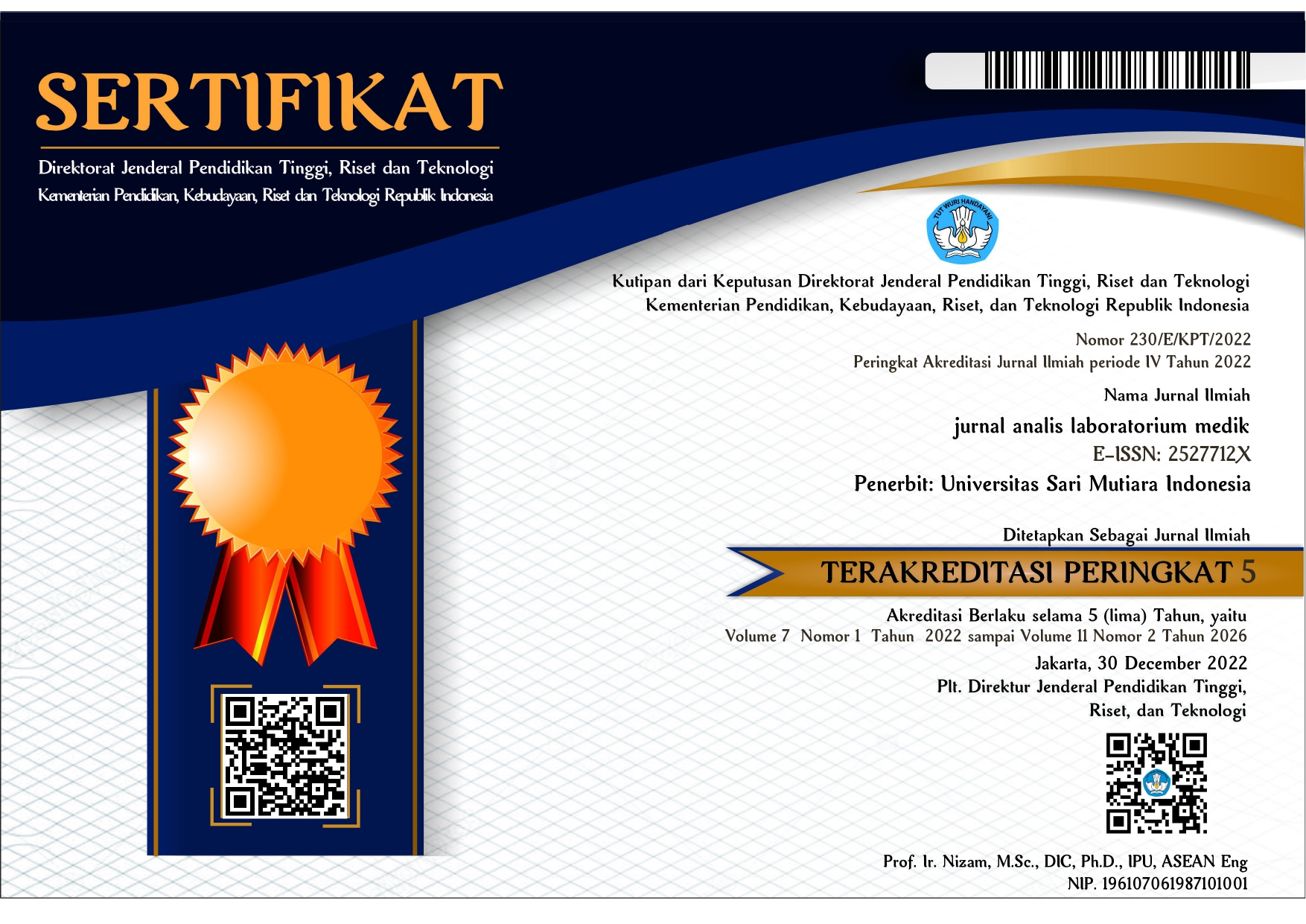Kualitas Bakteriologi Escherichia Coli dan Coliform pada Air di Distrik Demta Kabupaten Jayapura Tahun 2022
DOI:
https://doi.org/10.51544/jalm.v7i2.3384Keywords:
Demta, Escherichia coli, MPNAbstract
Clean water is water used for daily needs with quality that meets hygiene requirements. Poor environmental sanitation can increase the deposit of microorganisms in water. Water containing microorganisms can cause disease. This study aims to determine the number of Escherichia coli bacteria and groups of coliform bacteria. This research includes laboratory observational research. Water samples were obtained from springs and community shelters. Identification and numeration using the MPN (most probable number) method. The media used were Lactose Broth (LB), Brillian Green Lactose Broth (BGLB) and EC Broth with three tubes. The results of the study identified the presence of Coliform and E.coli bacteria. The numerical results on Coliform show only one sample that meets the quality standards. The results of the numeration of E.coli bacteria, all samples did not meet the quality standards of the Minister of Health Regulation No. 32 of 2017. Bacterial contamination is thought to be the result of community activities using water sources as a place for bathing and washing. The conclusion of this study is that the water used for the daily needs of the people of Demta is contaminated with coliform and E.coli.
Downloads
References
Afif Fathoni and Erly, E. (2015) ‘Identifikasi Bakteri Escherichia coli pada Air Minum Isi Ulang yang Diproduksi Depot Air Minum Isi Ulang di Kecamatan Padang Selatan’, Jurnal Kesehatan Andalas, 4(2)
Bhima Rochman Satya Haprabu, Hardany Primarizky, Prima Ayu Wibawati, W. H. (2018) ‘Isolasi dan Identifikasi Cemaran Bakteri Escherichia Coli pada Telur Penyu Lekang (Lepidochelys olivacea) yang Gagal Menetas Menetas di Sarang Semi Alami Pantai Boom Banyuwangi’, Jurnal Medik Veteriner, 1(3)
Dewi Noor Vita Sari, Putri Kartika Sari, D. R. (2018) ‘Deteksi Mpn Coliform Pada Air Minum Isi Ulang Di Kecamatan Pengaron Juni 2018’, akademi analis kesehatan banjar baru, 74(mikrobiologi air)
Fadilasani Tyas Utami, M. M. (2020) ‘Metode Most Probable Number ( MPN ) Sebagai Dasar Uji Kualitas Air Sungai Rengganis Dan Pantai Timur Pangandaran Dari Cemaran Coliform Dan Escherichiacoli Most Probable Number ( MPN ) Method As A Basic Test Of Coliform and Escherichia coli Pollution’, Jurnal kesehatan bakti tunas husada, 20(1)
Jamilatun, M. and Aminah, A. (2016) ‘Isolasi Dan Identifikasi Escherichia Coli Pada Air Wudhu Di Masjid Yang Berada Di Kota Tangerang’, Jurnal Medikes (Media Informasi Kesehatan), 3(1)
Kurniawan, F. B. et al. (2022) ‘Kadar Klor Terhadap Kualitas Bakteriologi Pada Air Kolam’, Gema Kesehatan.
Kurniawan, F. B., Asrori, A. and Alfreda, Y. W. K. (2021) ‘Identifikasi Bakteri Escherichia coliMetode MPN Pada Air Isi Ulang Diperumnas Iv Waena Abepura TAHUN 2021’, Gema Kesehatan, 13(1)
Kurniawan F.B, I. T. S. (2018) Bakteriologi Praktikum Teknologi Laboratorium Medik.
Permenkes No. 492 (2010) ‘Persyaratan Kualitas Air Minum’, Peraturan Mentri Kesehatan Republik Indonesia.
Sunarti, R. N. (2016) ‘Uji Kualitas Air Sumur Dengan Menggunakan Metode MPN (Most Probable Numbers)’, Bioilmi, 1(1).
Wahyu Zikra, Arni Amir, A. E. P. (2018) ‘Identifikasi Bakteri Escherichia coli (E.coli) pada Air Minum di Rumah Makan dan Cafe di Kelurahan Jati serta Jati Baru Kota Padang’, Jurnal Kesehatan Andalas, 7(2)
Kumala, I. G. A. H., Astuti, N. P. W., & Sumadewi, N. L. U. (2019). Uji Kualitas Air Minum Pada Sumber Mata Air di Desa Baturiti, Kecamatan Baturiti, Kabupaten Tabanan. HIGIENE: Jurnal Kesehatan Lingkungan, 5(2), 100-105.
Downloads
Published
How to Cite
Issue
Section
License
Copyright (c) 2022 Fajar Bakti Kurniawan, Meidy Johana Imbiri, Asrori, Yulianus Wisma Krisna Alfreda, Asrianto, Indra Taufik Sahli, Risda Hartati

This work is licensed under a Creative Commons Attribution-ShareAlike 4.0 International License.
Syarat yang harus dipenuhi oleh Penulis sebagai berikut:
Â
- Penulis menyimpan hak cipta dan memberikan jurnal hak penerbitan pertama naskah secara simultan dengan lisensi di bawah Creative Commons Attribution License yang mengizinkan orang lain untuk berbagi pekerjaan dengan sebuah pernyataan kepenulisan pekerjaan dan penerbitan awal di jurnal ini.
- Penulis bisa memasukkan ke dalam penyusunan kontraktual tambahan terpisah untuk distribusi non ekslusif versi kaya terbitan jurnal (contoh: mempostingnya ke repositori institusional atau menerbitkannya dalam sebuah buku), dengan pengakuan penerbitan awalnya di jurnal ini.
- Penulis diizinkan dan didorong untuk mem-posting karya mereka online (contoh: di repositori institusional atau di website mereka) sebelum dan selama proses penyerahan, karena dapat mengarahkan ke pertukaran produktif, seperti halnya sitiran yang lebih awal dan lebih hebat dari karya yang diterbitkan. (Lihat Efek Akses Terbuka).










